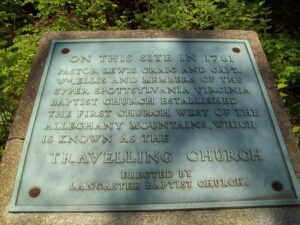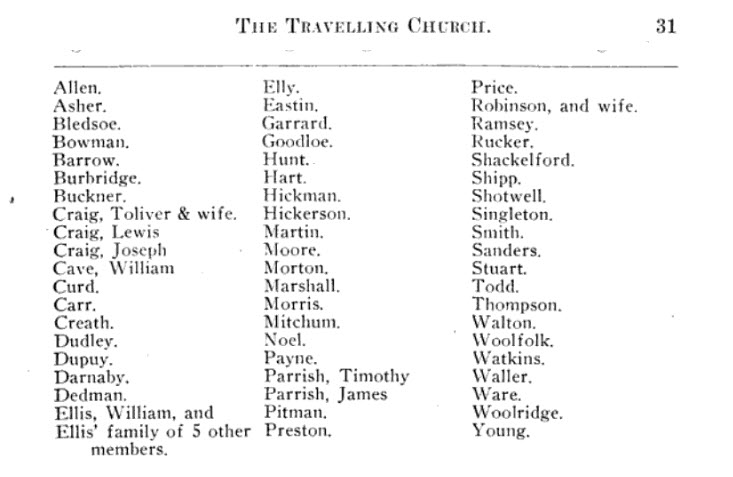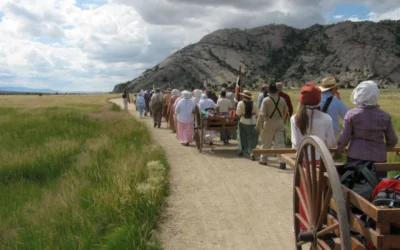Embark on a fascinating journey through Kentucky’s religious history as we explore the renowned Traveling Church. Led by the talented and resilient Reverend Elijah Craig, this group of early settlers ventured from Virginia to Kentucky in search of religious freedom. From Craig’s imprisonment for preaching to the formation of this pioneer congregation, discover the remarkable tale of the Traveling Church and its lasting impact on Kentucky’s religious landscape.
As you will learn in this post, there was more than one of these churches but they were important to early Kentucky religious history.
Elijah Craig Imprisoned for Being a Reverend
Elijah Craig was the talented and dynamic pastor of Upper Spotsylvania Church. At that time, it was against the law of Virginia to preach without a license. The Separate Baptists, the group to which Craig belonged, opposed the license law. In 1768, Craig became the first man imprisoned “for preaching contrary to the laws for the maintenance of the church establishment of England.”
Probably largely because of such restrictions, several members of Craig’s church decided to move to Kentucky, where they felt they would have more freedom. Under Thomas Jefferson’s leadership in 1776, the penal laws against Dissenters were repealed.
Roots of the Traveling Church
The group, which left Spotsylvania County in September 1781, included church members, their children, [enslaved people], and other emigrants totaling between five and six hundred. This was the largest body of Virginians that ever set out for Kentucky at one time. The church took along its official books and records, its communion service, and the pulpit Bible.
The group traveled southwesterly, past Charlottesville and Lynchburg, to Fort Chiswell, near the present Wytheville, where they had to give up their wagons. There was to be no wagon road into Kentucky until several years later. The rest of the journey would be on foot and horseback.
They were delayed at Black’s Fort at Wolf Hills (now Abingdon, Virginia) by reports of [Native American] threats along the road. There they found several emigrants from Orange County in their own section of Virginia. Craig aided in constituting them a church. That group stayed at Wolf Hills for three years before it came to Kentucky, where they settled in Garrard County, then moved on to Lower Howard’s Creek in what is now Clark County.
The Traveling Church
The settlement there was called Bush’s Station. They built a stone church, called Providence, which is still standing and in use by a Black congregation. Since its experience paralleled somewhat that of Upper Spotsylvania, it, too, has sometimes been referred to as “The Traveling Church.”
The route to Kentucky for Craig’s congregation led from Wolf Hills through Lee County, Virginia, through Cumberland Gap into Kentucky. Following the Wilderness Trail, they passed the site of Barbourville, over the spot now occupied by the Laurel County Courthouse in London, then across Rockcastle River, to Mt. Vernon, Crab Orchard, and Logan’s Fort (now Stanford).

Memorial tablet on a monument atop the hill at Gilbert’s Creek, Kentucky, where the famous Travelling Church built their first fortified hill church in the wilderness of pioneer Kentucky in 1782.
Source: Wikimedia
In December 1781, they arrived on Gilbert’s Creek, two and a half miles southeast of Lancaster. There, they built a fort and a log church, later replaced by a brick one. Ranck says they “were the first church that ever assembled in Central Kentucky.” Others count Gilbert’s Creek as the third, crediting Severn’s Valley at Elizabethtown as the first (18 June 1781) and Cedar Creek in Nelson County as the second (4 July 1781). Gilbert’s Creek was the first to come as an organized church.
In 1783, Elijah Craig and some members moved to South Elkhorn on the Harrodsburg Road, about five miles from Lexington, where they established the first church organized in Kentucky north of the Kentucky River. This, too, has been referred to as “The Traveling Church.”
Craig also established a distillery there and is often attributed as the inventor of bourbon; however, that is a story for another day.
The modern-day successor to this congregation is the South Elkhorn Christian Church (Disciples of Christ). In 1792, Elijah Craig moved to Mason County, where he died in 1825 in his eighty-fifth year.
From his obituary in the Kentucky Gazette, “He possessed a mind extremely active and, as his whole property was expended in attempts to carry his plans to execution, he consequently died poor. If virtue consists in being useful to our fellow citizens, perhaps there were few more virtuous men than Mr. Craig.”
Aftermath
After Craig and several members of the Gilbert’s Creek congregation left, the organization rapidly declined, and by 1786, a committee reported that the Gilbert’s Creek Regular Baptist Church was extinct. Forrest Calico says that the spot now marked by a tablet as the site of the Traveling Church is actually the site of the Separate Baptist Church organized in 1783. The site is a mile west of Craig’s Station.
Surnames Associated with the Traveling Church
Ranck says there is no list extant of the members of the original Traveling Church, but the surnames of some of them have been preserved.

Surnames listed on page 31 of The Traveling Church. [Source: Google Books]
Author’s Notes
In his book The Traveling Church (published 1891), author George W. Ranck gives a graphic picture of the journey to Kentucky. Anyone interested in reading more about the migration to Kentucky from 1780 to 1800 will find the complete book useful.
Editor’s Notes
Artwork Credit: Courtesy of Olorin3k at Wikimedia



